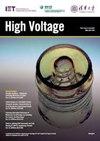Thermal Conductive Network Construction and Enhanced Thermal Conductivity in Mica Tape Composites for Large Generators by Pre-Placed h-BN@PDA-Modified Mica Paper
IF 4.9
2区 工程技术
Q1 ENGINEERING, ELECTRICAL & ELECTRONIC
引用次数: 0
Abstract
The lower thermal conductivity (TC) of mica tape hinders the evolution of large generators towards higher voltage and capacity. To enhance the TC of the mica tape, with the help of the three-dimensional (3D) multi-layer framework of the mica paper, a 3D polydopamine-coated boron nitride (h-BN@PDA) TC network was constructed by pre-placing h-BN@PDA inside the mica paper. Additionally, the above mica paper and epoxy-impregnated glass fabric were pressed to manufacture mica tape composites. Although the h-BN percentage remained constant, the TC of the h-BN@PDA/mica paper (or tape) composites could be further enhanced by depositing PDA over the h-BN surface. The TC of the 25wt.% h-BN@PDA/mica paper and mica tape composites reached 1.12 and 0.435 W/(m·K), which were 169.23% and 83.5% in comparison to pure mica paper and mica tape, respectively, also higher than those of the 25wt.% h-BN/mica paper and mica tape composites (1.07 and 0.416 W/(m·K), respectively). As calculated from theoretical modelling, this enhancement is due to the ability of the PDA coating to act as a ‘bridge’ to reduce the interfacial thermal resistance (ITR). In conclusion, the 3D TC network construction method in this research offers a new concept and strategy for manufacturing high-TC mica tapes.预置云母纸构建大型发电机用云母带复合材料导热网络及增强导热性能h-BN@PDA-Modified
云母带的低热导率(TC)阻碍了大型发电机向更高电压和容量的发展。为了增强云母带的TC,借助云母纸的三维(3D)多层框架,将h-BN@PDA预置于云母纸内部,构建三维聚多巴胺包覆的氮化硼(h-BN@PDA) TC网络。此外,将上述云母纸与环氧浸渍玻璃布进行压制制成云母带复合材料。虽然h-BN的百分比保持不变,但在h-BN表面沉积PDA可以进一步提高h-BN@PDA/云母纸(或云母带)复合材料的TC。25wt的TC。% h-BN@PDA/云母纸和云母带复合材料达到1.12和0.435 W/(m·K),分别比纯云母纸和纯云母带高169.23%和83.5%,也高于25wt。% h-BN/云母纸和云母带复合材料(分别为1.07和0.416 W/(m·K))。根据理论模型计算,这种增强是由于PDA涂层作为“桥”的能力,以降低界面热阻(ITR)。总之,本研究的三维TC网络构建方法为制造高TC云母带提供了新的概念和策略。
本文章由计算机程序翻译,如有差异,请以英文原文为准。
求助全文
约1分钟内获得全文
求助全文
来源期刊

High Voltage
Energy-Energy Engineering and Power Technology
CiteScore
9.60
自引率
27.30%
发文量
97
审稿时长
21 weeks
期刊介绍:
High Voltage aims to attract original research papers and review articles. The scope covers high-voltage power engineering and high voltage applications, including experimental, computational (including simulation and modelling) and theoretical studies, which include:
Electrical Insulation
● Outdoor, indoor, solid, liquid and gas insulation
● Transient voltages and overvoltage protection
● Nano-dielectrics and new insulation materials
● Condition monitoring and maintenance
Discharge and plasmas, pulsed power
● Electrical discharge, plasma generation and applications
● Interactions of plasma with surfaces
● Pulsed power science and technology
High-field effects
● Computation, measurements of Intensive Electromagnetic Field
● Electromagnetic compatibility
● Biomedical effects
● Environmental effects and protection
High Voltage Engineering
● Design problems, testing and measuring techniques
● Equipment development and asset management
● Smart Grid, live line working
● AC/DC power electronics
● UHV power transmission
Special Issues. Call for papers:
Interface Charging Phenomena for Dielectric Materials - https://digital-library.theiet.org/files/HVE_CFP_ICP.pdf
Emerging Materials For High Voltage Applications - https://digital-library.theiet.org/files/HVE_CFP_EMHVA.pdf
 求助内容:
求助内容: 应助结果提醒方式:
应助结果提醒方式:


